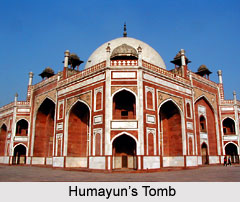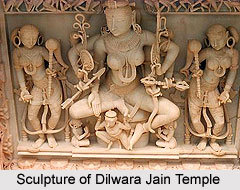 Art in medieval India is the final and inevitable development of the maturity of Gupta art. The Hindu sculptures, paintings and architectures are the most important works of medieval art in India. In the north the invasion of the Delhi sultanate and the Mughals brought in the indo Islamic art which is an important movement in the history of medieval art in India. The paintings of the Rajput school of art are of great significance during this era. The architecture of the medieval period is regarded from its metaphysical aspect, that is, as a kind of magic replica of some unseen region or sacred being; and that it was precisely this metaphysical factor that determined the plan and elevation, rather than any aesthetic or functional consideration.
Art in medieval India is the final and inevitable development of the maturity of Gupta art. The Hindu sculptures, paintings and architectures are the most important works of medieval art in India. In the north the invasion of the Delhi sultanate and the Mughals brought in the indo Islamic art which is an important movement in the history of medieval art in India. The paintings of the Rajput school of art are of great significance during this era. The architecture of the medieval period is regarded from its metaphysical aspect, that is, as a kind of magic replica of some unseen region or sacred being; and that it was precisely this metaphysical factor that determined the plan and elevation, rather than any aesthetic or functional consideration.
During the early thirteenth century, the Delhi Sultanates invaded the most of northern India. The Delhi sultanates included the Mamluk dynasty (1206-90), the Khilji dynasty (1290-1320), the Tughlaq dynasty (1320-1413), the Sayyid dynasty (1414-51) and the Lodhi dynasty (1451-1526). New techniques of art and architecture were introduced by them which were soon absorbed by the existing set up. There were many features in the Indian style of art which were similar to that of the foreign architectures for example both mosques and temples had open courtyards. This fact made the adaptation easier. In the art and architecture of this period a blend of Indian and foreign style was observed. The dome and the pointed arch were pioneered by the sultanates of Delhi which were considered as significant enhancing structure of the Islamic buildings. These exclusive styles were gradually incorporated in other structures as well. The local Indian craftsmen were trained in this Persian style of art which they used to adorn the structure. The Indian craftsmen incorporated their own thoughts which resulted in the fact that conventional Hindu patterns like the lotus found their way into Islamic structures.
The slave and the Khilji dynasty were the early dynasties of the sultanate period. They fashioned some elegantly planned structures, with fine works of art ornamenting them. Art and architecture was less adorned and more uncomplicated and sober during the reign of the Tughlaq whereas the Sayyids and the Lodhis incorporated more prolific style of art and introduced the idea of double dome. This innovative type of ornamentation was highly influenced by the Persian style. Art in terra cotta was also in vogue during this epoch. This period was marked with great experimentation done in the fields of art by the Indian artists. They amalgamated the Indian techniques with the new ideas of the foreigners which resulted in the formation of a coherent whole.
The Delhi sultanates were absorbed by the Mughals who invaded India in the year 1526. The Mughals brought in the Indo- Islamic – Persian blend of art and architecture which included the features of Islamic art and architecture which had been introduced in India by the sultanates of Delhi. Medieval art in India reached its zenith during the reign of the Mughals. Humayun"s tomb at Delhi embodies a marvelous landmark in the expansion and sophistication of the Mughal style. But it was under the rule of Akbar that art attained its highest peak. The huge Agra fort was a major architectural production during Akbar. The establishment of the capital city of Fatehpur Sikri and the huge fortification of the Red fort are among the others architectural magnificence during this era. The sand stones architectures of Akbar were replaced by marble masterpieces by his successors. The Taj Mahal built by Shah Jahan is a lavish marble architecture. The Mughals were great patrons of art and their intellectual competence and artistic view was articulated in the most sophisticated manner. With the Muslim invasion, Sufism gained an entry in the Indian panorama.
The art and architecture of the Rajputs holds a special position in the history of medieval art. The Rajputs were connoisseur of art and architecture which is reflected in the temples, forts and palaces built by them. The later Rajput period included the temple architecture of Orissa, Khajuraho, Rajasthan, Madhya Pradesh and the temples of the Pallava and the Hoysalas in the south. The Khajuraho temples constructed by the Chandela rulers belong to the Vaishnava, Shaiva and the Jain sects. The temples are built in well grained sand stone and are put up on a high platform terrace. The temples have a covered entrance, a hall, a vestibule and a sanctorum. The temple of Vijayanagar at Hampi is an important medieval architecture of India.
 Architecture reached an elevated level of artistic excellence in the 11th and 12th century AD during the rule of the Chalukyas. It is witnessed in the architecture of the Jain temples of Gujarat. The Dilwara Jain temple at Mount Abu in Rajasthan is constructed in white marbles and is set up on a high platform with a compartment preserving a deity surrounded by a walled patio. There are other shrines around the courtyard which has images of Jain Tirthankaras. The oldest palaces of the Rajputs are found in Chittor and Gwalior which dates from the mid fifteenth century. The Man mandir of Gwalior is enhanced in brilliant blue tiles. The skill and maturity of the Rajput style are evident in the palaces of Bikaner, Jodhpur, Jaisalmer and Udaipur. The buildings of the vast equipped city of Jaisalmer are constructed with yellow brown stone and the city of Bikaner is done in rich pink sand stone. The pink city of Jaipur marks the final phase of Rajput architecture. The town planning represents an intermingling of eastern and western ideas. The City Palace is at the hub of the walled city and is an impressive fusion of Rajput and Mughal architectural techniques.
Architecture reached an elevated level of artistic excellence in the 11th and 12th century AD during the rule of the Chalukyas. It is witnessed in the architecture of the Jain temples of Gujarat. The Dilwara Jain temple at Mount Abu in Rajasthan is constructed in white marbles and is set up on a high platform with a compartment preserving a deity surrounded by a walled patio. There are other shrines around the courtyard which has images of Jain Tirthankaras. The oldest palaces of the Rajputs are found in Chittor and Gwalior which dates from the mid fifteenth century. The Man mandir of Gwalior is enhanced in brilliant blue tiles. The skill and maturity of the Rajput style are evident in the palaces of Bikaner, Jodhpur, Jaisalmer and Udaipur. The buildings of the vast equipped city of Jaisalmer are constructed with yellow brown stone and the city of Bikaner is done in rich pink sand stone. The pink city of Jaipur marks the final phase of Rajput architecture. The town planning represents an intermingling of eastern and western ideas. The City Palace is at the hub of the walled city and is an impressive fusion of Rajput and Mughal architectural techniques.
The medieval painting is the work of the Rajput schools. Rajput painting is the work of artists attached to the princely courts in Rajasthan, Central India, and the Himalayan foothills of the Punjab from about the sixteenth to the nineteenth centuries. It is a style of painting that is apart in subject-matter and conception from the exactly contemporary work of the artists attached to the courts of the Mughals. Rajput painting always remained entirely traditional in its illustration of the Indian epics, romantic Vaishnava literature, and musical modes. The development of the Rajput school of painting is the pictorial counterpart of the vernacular literature of Hindustan. The Rajput miniatures are derived from earlier classic styles. In this regard Rajput art might be presented as a merging of folk art with hieratic and classic traditions. The Rajput paintings are in a sense the product of the development of popular Vaishnavism centered particularly on the devotion to Lord Rama and Lord Krishna who typified the worship of Vishnu and Shiva in their more accessible and loving aspects rather than in the hieratic form in which they were venerated according to Vedic ritual. The rise of popular Vaishnavism coincides with the renaissance of Hindu literature and the begin¬nings of Rajput painting in the late sixteenth century. Rajput paintings are usually on a small scale, although many of them are very obviously reductions of themes originally employed in mural compositions.
In India art in the medieval period witnesses a wide range of development and progress. The architecture and sculpture of this era is marked with indo Islamic style and also the continuation of the native art and architecture.



















